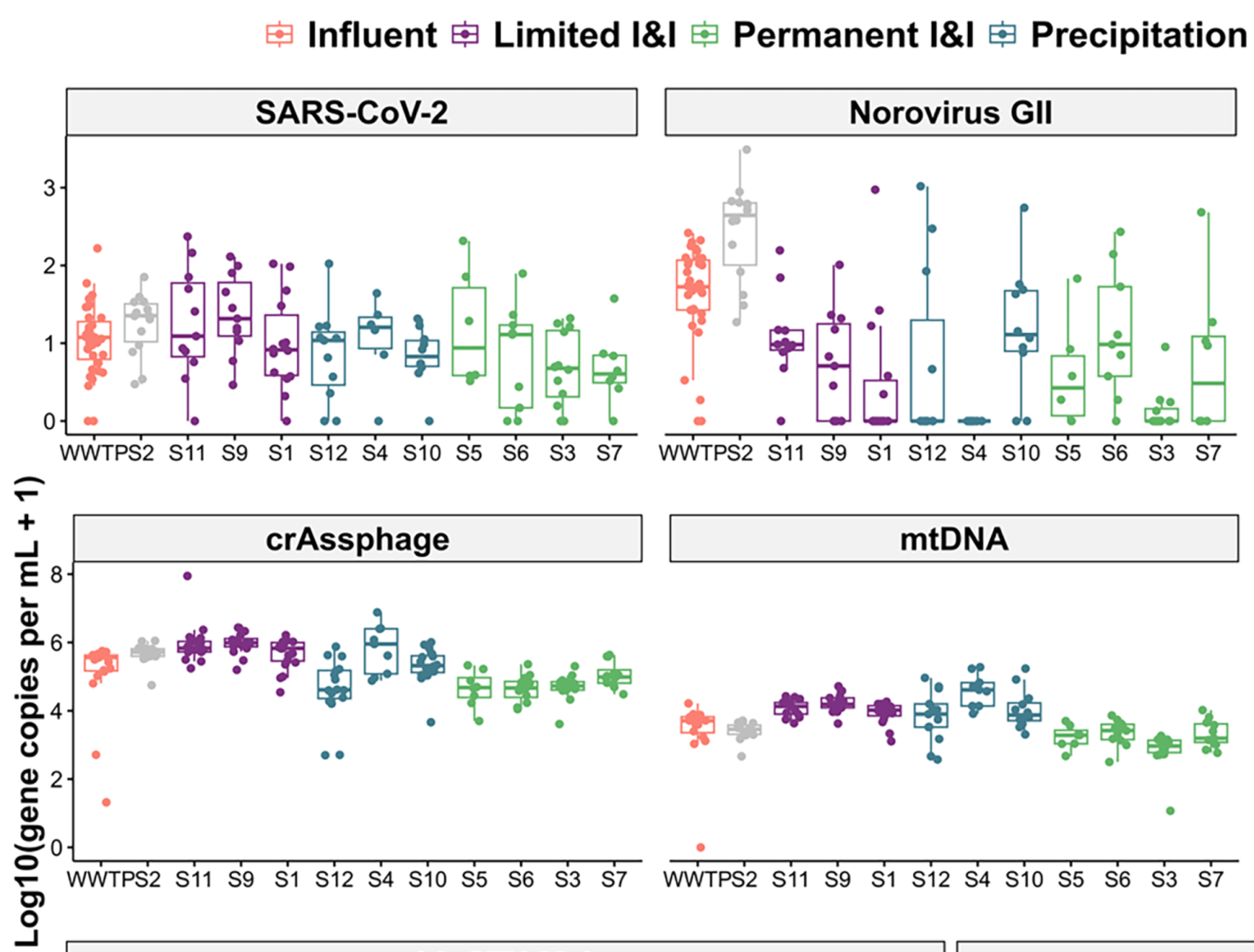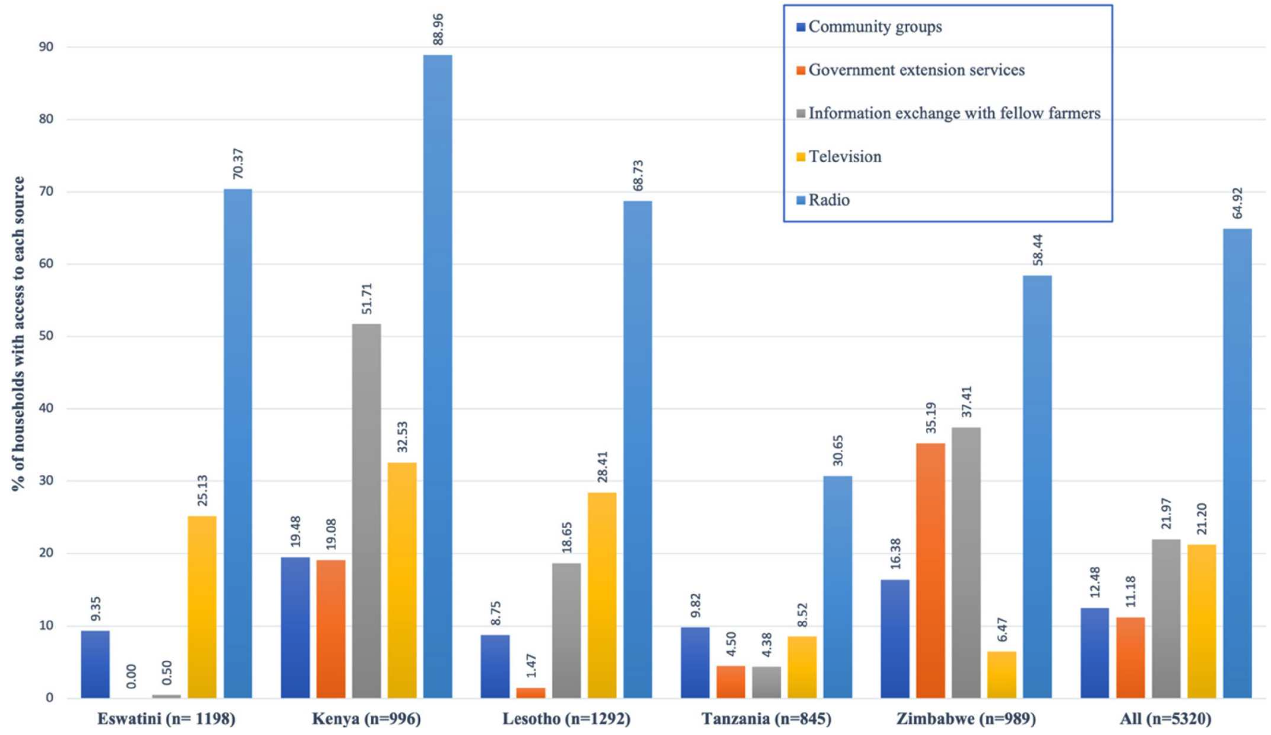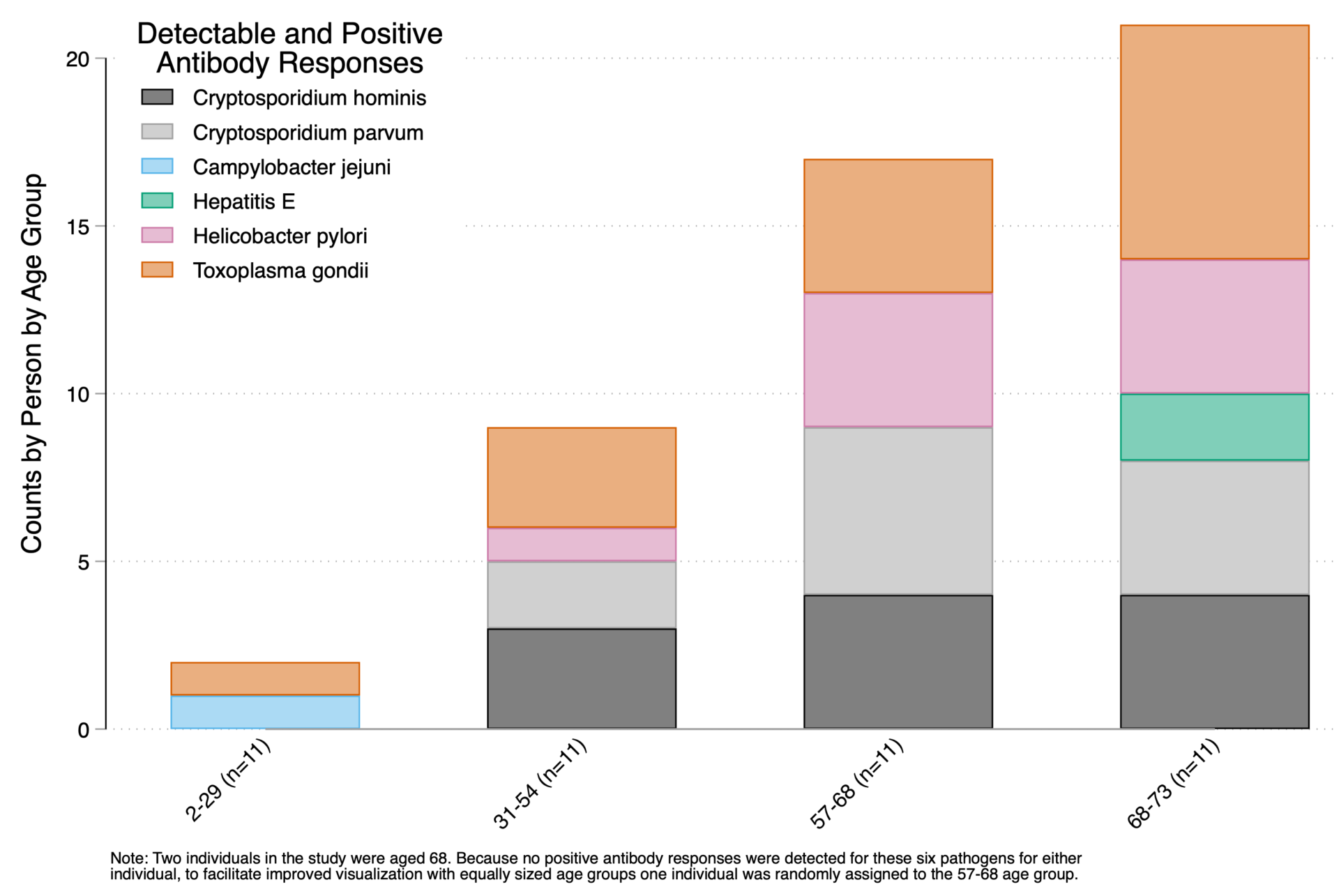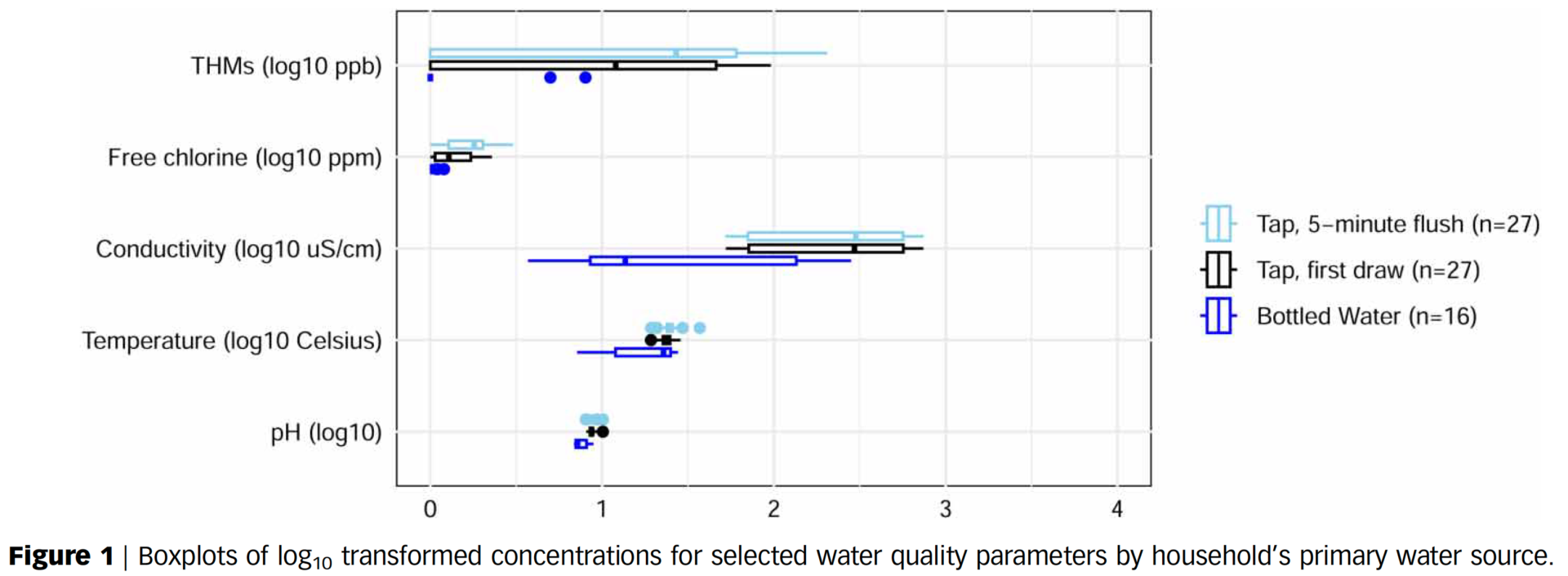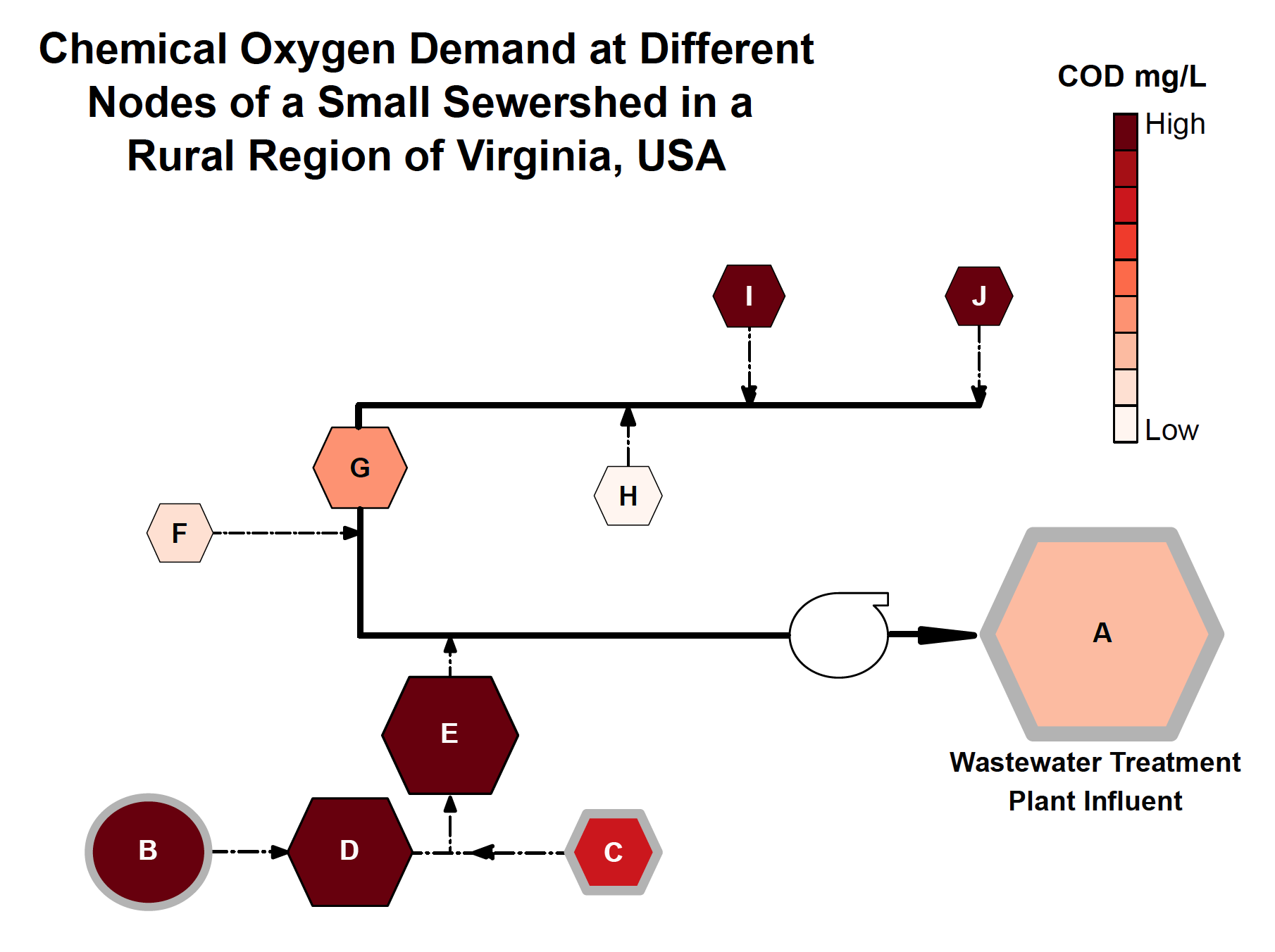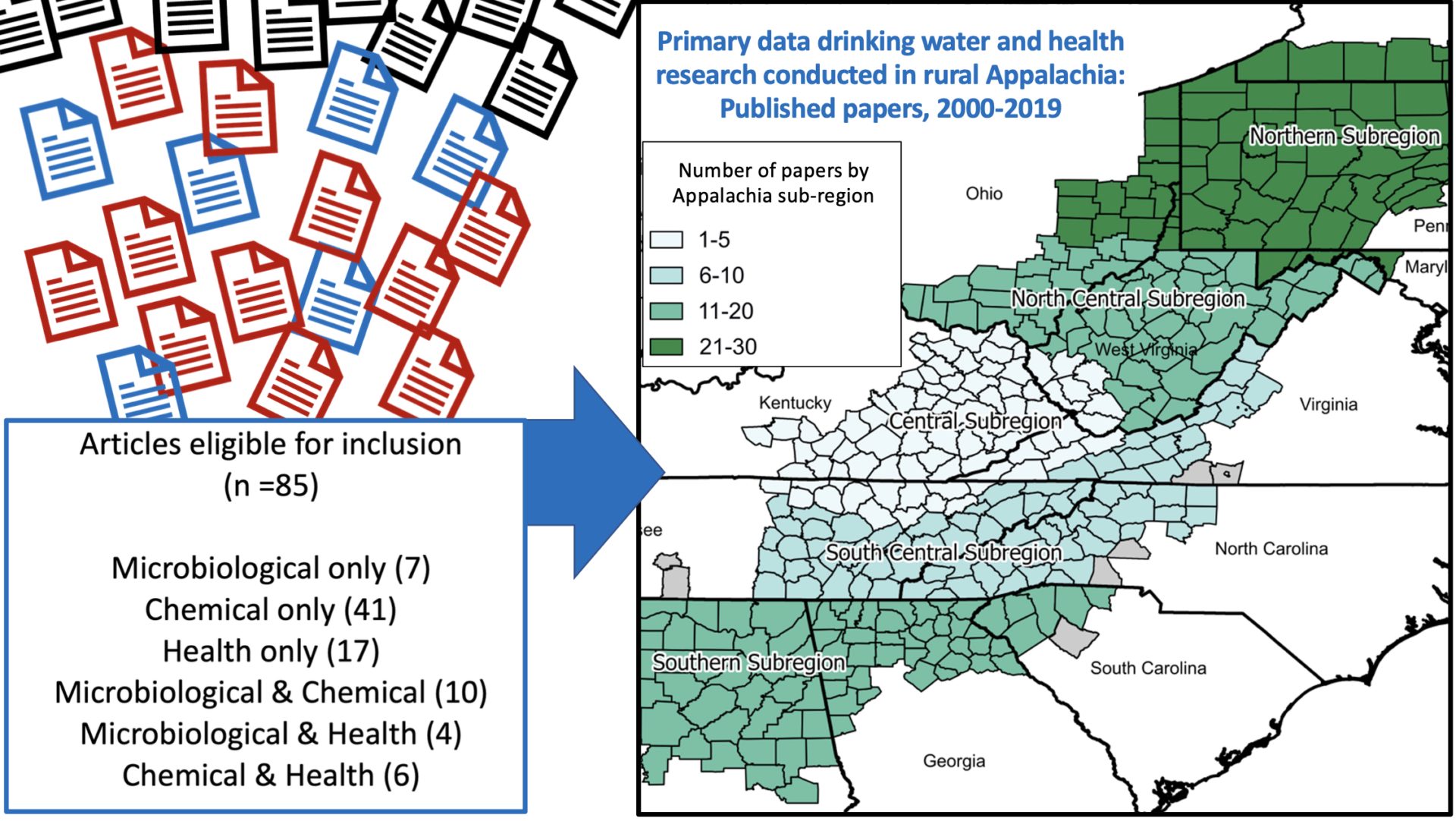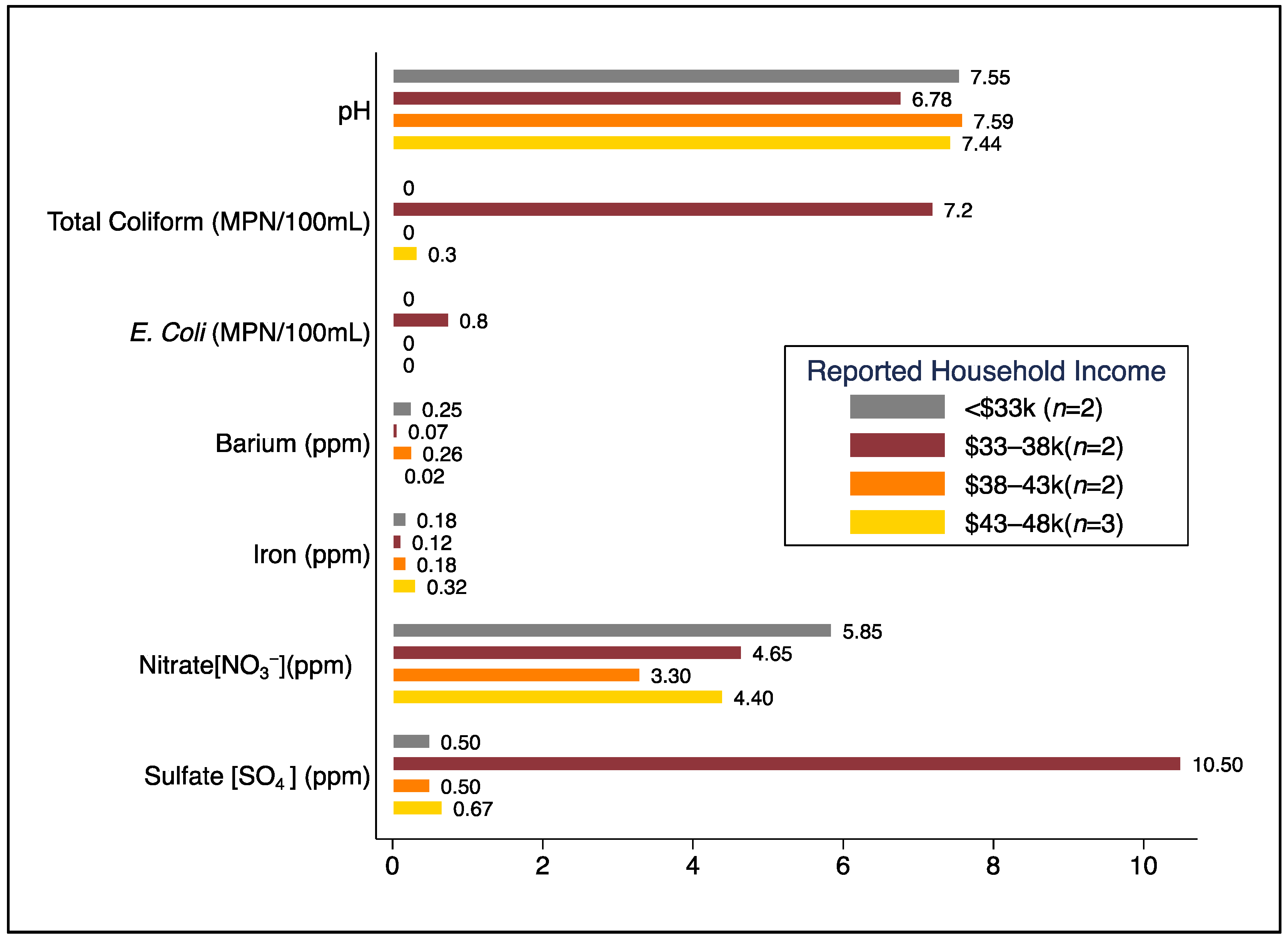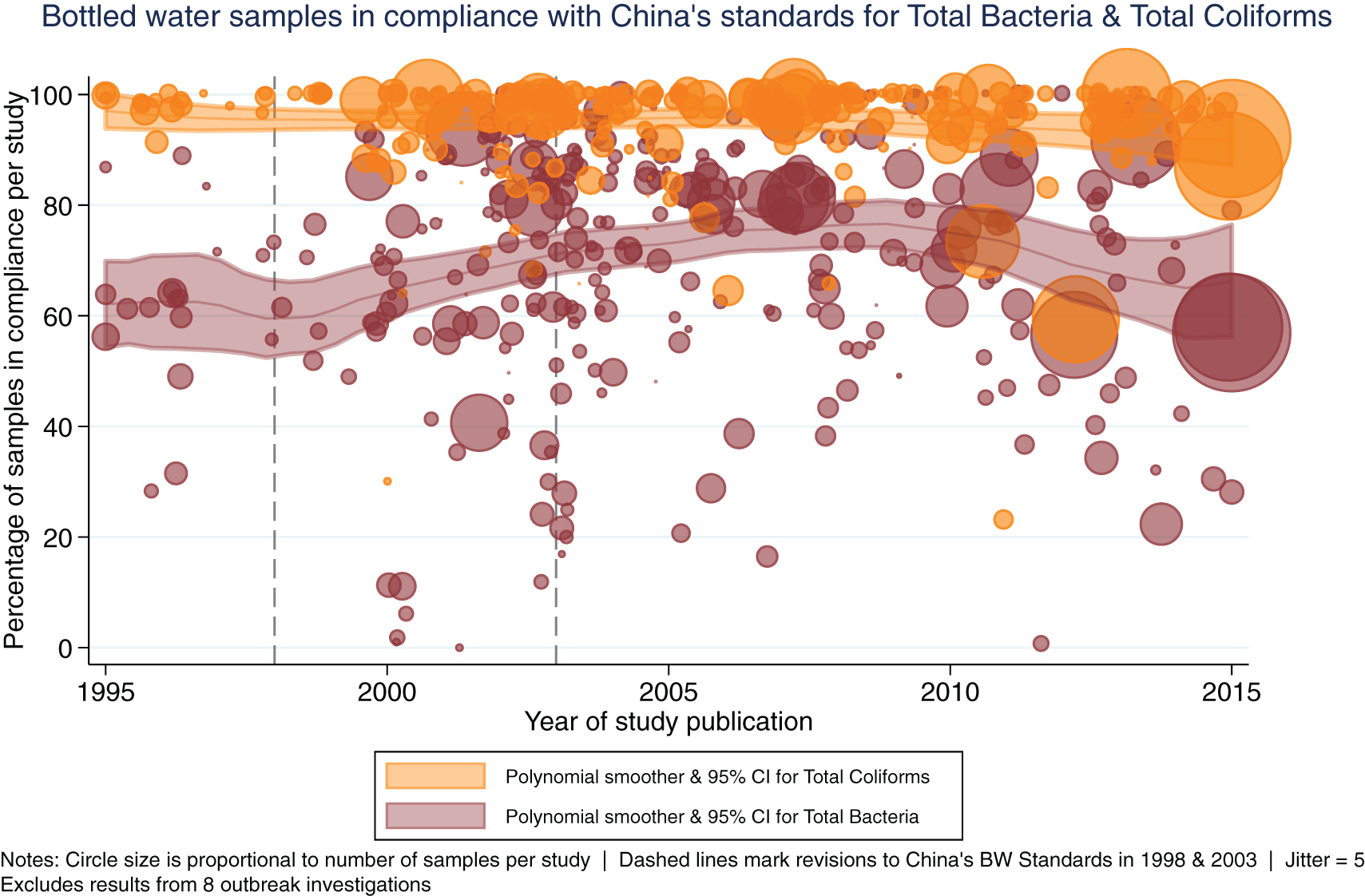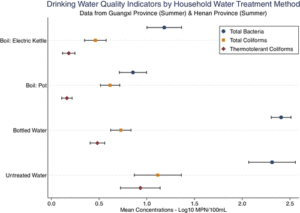Subsewershed analyses of the impacts of inflow and infiltration on viral pathogens and antibiotic resistance markers across a rural sewer system
Authors: Darling, A., Davis, B., Byrne, T., Deck, M., Rivera, G., Price, S., Amaral-Torres, A., Markham, C., Gonzalez, R., Vikesland, P., Krometis, L.-A., Pruden, A., & Cohen, A.*
Publication Year: 2025 | Journal / Publisher: Water Research
Abstract/Summary: As wastewater-based surveillance (WBS) is increasingly used to track community-level disease trends, it is important to understand how pathogen signals can be altered by phenomena that occur within sewersheds such as inflow and infiltration (I&I). Our objectives were to characterize I&I across a rural sewershed and assess potential impacts on viral (rotavirus, norovirus GII, and SARS-CoV-2), fecal indicator (HF183, the hCYTB484 gene specific to the human mitochondrial genome, and crAssphage), and antimicrobial resistance (intI1, blaCTX−M-1) targets. In a small town in Virginia (USA), we collected 107 wastewater samples at monthly intervals over a 12-month period (2022–2023) at the wastewater treatment plant (WWTP) influent and 11 up-sewer sites. Viral, fecal indicator, and antimicrobial resistance targets were enumerated using ddPCR. We observed the highest concentrations of human fecal markers and a measure anthropogenic pollution and antibiotic resistance (intI1) in up-sewer sites with limited I&I. However, median viral gene copy concentrations were highest at the WWTP, compared to 100 % (n = 11), 90 % (n = 10), and 55 % (n = 6) of up-sewer sites for rotavirus, norovirus GII, and SARS-CoV-2, respectively. After adjusting for covariates (Ba, COD, dissolved oxygen, groundwater depth, precipitation, sampling date) using generalized linear models, moderate to high I&I was associated with statistically significant reductions in log10-transformed rotavirus and norovirus GII concentrations across the sewershed (coefficients = -0.7 and -0.9, p < 0.001, n = 95), though not for SARS-CoV-2 (coefficient = -0.2, p = 0.181, n = 95). Overall, we found that while I&I can diminish biomarker signals throughout a sewershed, including at the WWTP influent, I&I impacts vary depending on the target, and pathogen biomarker signals were, on average, higher and less variable over time at the WWTP compared to most up-sewer sites. As far as we are aware, this is the first study to assess in situ I&I impacts on multiple WBS targets. Taken together, our findings highlight challenges and tradeoffs associated with different sampling strategies for different WBS targets in heavily I&I impacted systems.
PDF on Publisher Website | PDF on OSF
Climate information access and use in East and Southern Africa: identifying linkages between smallholder household characteristics and climate change adaptation
Authors: Minjauw, F. Rasheduzzaman, M., Huang, J., Lozano, A., Baumgartner, P., Doward, P., Clarkson, G., & Cohen, A.*
Publication Year: 2024 | Journal / Publisher: Climate and Development
Abstract/Summary: Climate change adversely impacts the livelihoods of smallholder farmers across East and Southern Africa. Climate-related information is assumed to support smallholder farmer decision-making and use of adaptive practices as a means to improve livelihoods, resiliency and levels of food security. However, the value of climate information provision and its role in promoting adaptive practices remains poorly understood. We examined smallholder household access to, and use of, climate information. Survey data was collected from 5322 households across Eswatini, Kenya, Lesotho, Tanzania and Zimbabwe using the Multidimensional Poverty Assessment Tool. Overall, the majority of households regularly accessed at least one source of climate information, primarily via radio (64.9%, n = 3453). Our statistical models showed that households with relatively better access to credit and land tenure were more likely to receive climate information (p < 0.01 and p < 0.001, respectively, n = 1421), and of those, households who reported observing past climate-related changes were more likely to actually use climate information (p < 0.05, n = 1097). Secure land tenure was positively associated with information use, though not statistically significant. Findings from our study offer guidance for improving the targeting and delivery of climate information programmes and policies, and indicate that the assumed benefits of climate information provision should be more rigorously evaluated.
PDF on Publisher Website | PDF on OSF
Drinking water sources, quality, and associated health outcomes in Appalachian Virginia: A risk characterization study in two counties
Authors: Cohen*, Rasheduzzaman, O’Connell, Brown, Taniuchi, Krometis, Hubbard, Scheuerman, Edwards, Darling, Pennala, Price, Lytton, Wettstone, Pholwat, Ward, Hallinger, Simmons, Griffin, Kobylanski, Egorov, & Wade
Publication Year: 2024 | Journal / Publisher: International Journal of Hygiene and Environmental Health
Abstract/Summary: In the US, violations of drinking water regulations are highest in lower-income rural areas overall, and particularly in Central Appalachia. However, data on drinking water use, quality, and associated health outcomes in rural Appalachia are limited. We sought to assess public and private drinking water sources and associated risk factors for waterborne pathogen exposures for individuals living in rural regions of Appalachian Virginia. We administered surveys and collected tap water, bottled water, and saliva samples in lower-income households in two adjacent rural counties in southwest Virginia (bordering Kentucky and Tennessee). Water samples were tested for pH, temperature, conductivity, total coliforms, E. coli, free chlorine, nitrate, fluoride, heavy metals, and specific pathogen targets. Saliva samples were analyzed for antibody responses to potentially waterborne infections. We also shared water analysis results with households. We enrolled 33 households (83 individuals), 82% (n = 27) with utility-supplied water and 18% with private wells (n = 3) or springs (n = 3). 58% (n = 19) reported household incomes of <$20,000/year. Total coliforms were detected in water samples from 33% (n = 11) of homes, E. coli in 12%, all with wells or springs (n = 4), and Aeromonas, Campylobacter, and Enterobacter in 9%, all spring water (n = 3). Diarrhea was reported for 10% of individuals (n = 8), but was not associated with E. coli detection. 34% (n = 15) of saliva samples had detectable antibody responses for Cryptosporidium spp., C. jejuni, and Hepatitis E. After controlling for covariates and clustering, individuals in households with septic systems and straight pipes had significantly higher likelihoods of antibody detection (risk ratios = 3.28, 95%CI = 1.01–10.65). To our knowledge, this is the first study to collect and analyze drinking water samples, saliva samples, and reported health outcome data from low-income households in Central Appalachia. Our findings indicate that utility-supplied water in this region was generally safe, and individuals in low-income households without utility-supplied water or sewerage have higher exposures to waterborne pathogens.
PDF on Publisher Website | PDF on OSF
Perceptions of poverty: Evaluating Multidimensional Poverty Assessment Tool derived rankings and global development indicators in five African nations
Authors: Minjauw, F., Rasheduzzaman, M., Baumgartner, P., Doward, P., Clarkson, G., & Cohen, A.*
Publication Year: 2024 | Journal / Publisher: Journal of International Development
Abstract/Summary: This study assessed an array of indicators for rural poverty assessments and evaluated use of the Multidimensional Poverty Assessment Tool (MPAT) as a proxy for commonly used indicators, such as the Human Development Index, Gross National Income, Global Hunger Index, and the Gender Inequality Index. MPAT data from 5322 rural households across five countries in Africa were analyzed. While MPAT aligned well with development indicators for Kenya, Lesotho, and Tanzania, this was not the case for Eswatini and Zimbabwe. Overall, MPAT-based rankings correlated well with hunger, food security, and gender equality indicators. Our findings highlight the use of MPAT-derived indices as valuable supplements for commonly used development indicators.
PDF on Publisher Website | PDF on OSF
Point-of-use chlorine residuals and disinfection byproduct occurrences in rural households served by public water utilities in Appalachian Virginia
Authors: Rasheduzzaman, M, O’Connell, B., Krometis, L.-A., Brown, T., & Cohen, A.*
Publication Year: 2024 | Journal / Publisher: Journal of Water and Health
Abstract/Summary: We characterized concentrations of trihalomethanes (THMs), a measure of disinfection byproducts (DBPs), in tap water samples collected from households with utility-supplied water in two rural counties in Appalachian Virginia, and assessed associations with pH, free chlorine, and metal ions which can impact THM formation. Free chlorine concentrations in all samples (n = 27 homes) complied with EPA drinking water guidelines, though 7% (n = 2) of first draw samples and 11% (n = 3) of 5-min flushed-tap water samples exceeded the US Safe Drinking Water Act (SDWA) maximum contaminant level (MCL) for THM (80 ppb). Regression analyses showed that free chlorine and pH were positively associated with the formation of THM levels above SDWA MCLs (OR = 1.04, p = 0.97 and OR = 1.74, p = 0.79, respectively), while temperature was negatively associated (OR = 0.78, p = 0.38). Of the eight utilities serving study households, samples from water served by three different utilities exceeded the EPA MCL for THM. Overall, these findings do not indicate substantial exposures to DBPs for rural households with utility-supplied water in this region of southwest Virginia. However, given the observed variability in THM concentrations between and across utilities, and established adverse health impacts associated with chronic and acute DBP exposure, more research on DBPs in rural Central Appalachia is warranted.
PDF on Publisher Website | PDF on OSF
Making Waves: The Benefits and Challenges of Responsibly Implementing Wastewater-based Surveillance for Rural Communities
Authors: Cohen, A., Vikesland, P., Pruden, A., Krometis, L.-A., Lee, L.M., Darling, A., Yancey, M., Helmick, M., Singh, R., Gonzalez, R., Meit, M., Degen, M., & Taniuchi, M.
Publication Year: 2023 | Journal / Publisher: Water Research
Abstract/Summary: The sampling and analysis of sewage for pathogens and other biomarkers offers a powerful tool for monitoring and understanding community health trends and potentially predicting disease outbreaks. Since the early months of the COVID-19 pandemic, the use of wastewater-based testing for public health surveillance has increased markedly. However, these efforts have focused on urban and peri-urban areas. The potential public health benefits of wastewater-based surveillance for rural communities are substantial – though so too are the methodological and ethical challenges. Practitioner observations and research findings indicate that for many rural systems, typical implementation approaches for wastewater-based surveillance will not yield sufficiently reliable or actionable results. In this paper, we discuss key challenges and potential strategies to address them. However, to support and expand the implementation of responsible, reliable, and ethical wastewater-based surveillance for rural communities, best practice guidelines and standards are needed.
PDF on Publisher Website | PDF on OSF
Microbiological and chemical drinking water contaminants and associated health outcomes in rural Appalachia, USA: A systematic review and meta-analysis
Authors: Darling A., Patton H., Rasheduzzaman M., Guevera R., McCray J., Krometis L.A., & Cohen, A.
Publication Year: 2023 | Journal / Publisher: Science of The Total Environment
Abstract/Summary: In rural areas of the United States, an estimated ~1.8 million people lack reliable access to safe drinking water. Considering the relative dearth of information on water contamination and health outcomes in Appalachia, we conducted a systematic review of primary data studies published from 2000-2019. Of the 3,452 records identified for screening, 85 met our eligibility criteria. Most studies were conducted in Northern (32%, n=27) and North Central (24%, n=20) Appalachia, and only 6% (n=5) in Central Appalachia. Across studies, E. coli were detected in 10.6% of samples. 32% (n=27) of studies assessed health outcomes, but only 4.7% (n=4) used case-control or cohort designs (all others were cross-sectional). The most commonly reported outcomes were detection of PFAS in blood serum (n=13), gastrointestinal illness (n=5), and cardiovascular-related outcomes (n=4). Overall, based on the number and quality of eligible studies identified, we could not reach clear conclusions about the state of water quality, or its impacts on health, in any of Appalachia’s subregions. More epidemiologic research is needed to understand contaminated water sources, exposures, and potentially associated health outcomes in Appalachia.
PDF on Publisher Website | PDF on OSF
Bottled and Well Water Quality in a Small Central Appalachian Community: Household-Level Analysis of Enteric Pathogens, Inorganic Chemicals, and Health Outcomes in Rural Southwest Virginia
Authors: Cohen, A., Rasheduzzaman, M., Darling, A., Krometis, L.-A., Edwards, M., Brown, T., Ahmed, T., Wettstone, E., Pholwat, S., Taniuchi, M., & Rogawski McQuade, E. T.
Publication Year: 2022 | Journal / Publisher: International Journal of Environmental Research & Public Health
Abstract/Summary: Consumption of unsafe drinking water is associated with a substantial burden of disease globally. In the US, ~1.8 million people in rural areas lack reliable access to safe drinking water. Our objective was to characterize and assess household-level water sources, water quality, and associated health outcomes in Central Appalachia. We collected survey data and water samples (tap, source, and bottled water) from consenting households in a small rural community without utility-supplied water in southwest Virginia. Water samples were analyzed for physicochemical parameters, total coliforms, E. coli, nitrate, sulfate, metals (e.g., arsenic, cadmium, lead), and 30+ enteric pathogens. Among the 69% (n = 9) of households that participated, all had piped well water, though 67% (n = 6) used bottled water as their primary drinking water source. Total coliforms were detected in water samples from 44.4% (n = 4) of homes, E. coli in one home, and enteric pathogens (Aeromonas, Campylobacter, Enterobacter) in 33% (n = 3) of homes. Tap water samples from 11% (n = 1) of homes exceeded the EPA MCL for nitrate, and 33% (n = 3) exceeded the EPA SMCL for iron. Among the 19 individuals residing in study households, reported diarrhea was 25% more likely in homes with measured E. coli and/or specific pathogens (risk ratio = 1.25, cluster-robust standard error = 1.64, p = 0.865). Although our sample size was small, our findings suggest that a considerable number of lower-income residents without utility-supplied water in rural areas of southwest Virginia may be exposed to microbiological and/or chemical contaminants in their water, and many, if not most, rely on bottled water as their primary source of drinking water.
PDF on Publisher Website | PDF on OSF
Bottled water quality and associated health outcomes: A systematic review and meta-analysis of 20 years of published data from China
Authors: Cohen, A., Cui, J., Song, Q., Xia, Q., Huang, J., Yan, X., Guo, Y., Sun, Y., Colford, J. M., & Ray, I.
Publication Year: 2022 | Journal / Publisher: Environmental Research Letters
Abstract/Summary: Bottled water is a rapidly growing yet relatively understudied source of drinking water globally. In addition to concerns about the safety of bottled water, the adverse environmental health and social impacts associated with bottled water production, distribution, consumption, and reliance are considerable. Our objective was to comprehensively review, analyze, and synthesize ∼20 years of publicly available data on bottled water quality and associated health outcomes in China. We conducted a systematic review and meta-analysis of publicly available studies of bottled water quality and associated health outcomes in China published between 1995 and early 2016 (in Chinese and English). We pre-specified and registered our study protocol, independently replicated key analyses, and followed standardized reporting guidelines. Our search identified 7059 potentially eligible records. Following screening, after full-text review of 476 publications, 216 (reporting results from 625 studies) met our eligibility criteria. Among many findings, 93.7% (SD = 10.1) of 24 585 samples tested for total coliforms (n = 241 studies), and 92.6% (SD = 12.7) of 7261 samples tested for nitrites (n = 85 studies), were in compliance with China’s relevant bottled water standards. Of the studies reporting concentration data for lead (n = 8), arsenic (n = 5), cadmium (n = 3), and mercury (n = 3), median concentrations were within China’s standards for all but one study of cadmium. Only nine publications reported health outcome data, eight of which were outbreak investigations. Overall, we observed evidence of stable or increasing trends in the proportions of samples in compliance over the ∼20 year period; after controlling for other variables via meta-regression, the association was significant for microbiological but not chemical outcomes (p = 0.017 and p = 0.115, respectively). Bottled water is typically marketed as being safe, yet in most countries it is less well-regulated than utility-supplied drinking water. Given the trend of increasing bottled water use in China and globally—and the associated environmental health impacts—we hope this work will help to inform policies and regulations for improving bottled water safety, while further highlighting the need for substantially expanding the provision of safe and affordable utility-supplied drinking water globally.
PDF on Publisher Website | PDF on OSF
Subsewershed SARS-CoV-2 Wastewater Surveillance & COVID-19 Epidemiology Using Building-specific Occupancy & Case Data
Authors: Cohen, A.,Maile-Moskowitz, A., Grubb, C., Gonzalez, R. A., Ceci, A., Darling, A., Hungerford, L., Fricker, R. D., Finkielstein, C. V., Pruden, A., & Vikesland, P. J.
Publication Year: 2022 | Journal / Publisher: Environmental Science & Technology - Water
Abstract/Summary: To evaluate the use of wastewater-based surveillance and epidemiology to monitor and predict SARS-CoV-2 virus trends, over the 2020–2021 academic year we collected wastewater samples twice weekly from 17 manholes across Virginia Tech’s main campus. We used data from external door swipe card readers and student isolation/quarantine status to estimate building-specific occupancy and COVID-19 case counts at a daily resolution. After analyzing 673 wastewater samples using reverse transcription quantitative polymerase chain reaction (RT-qPCR), we reanalyzed 329 samples from isolation and nonisolation dormitories and the campus sewage outflow using reverse transcription digital droplet polymerase chain reaction (RT-ddPCR). Population-adjusted viral copy means from isolation dormitory wastewater were 48% and 66% higher than unadjusted viral copy means for N and E genes (1846/100 mL to 2733/100 mL/100 people and 2312/100 mL to 3828/100 mL/100 people, respectively; n = 46). Prespecified analyses with random-effects Poisson regression and dormitory/cluster-robust standard errors showed that the detection of N and E genes were associated with increases of 85% and 99% in the likelihood of COVID-19 cases 8 days later (incident–rate ratio (IRR) = 1.845, p = 0.013 and IRR = 1.994, p = 0.007, respectively; n = 215), and one-log increases in swipe card normalized viral copies (copies/100 mL/100 people) for N and E were associated with increases of 21% and 27% in the likelihood of observing COVID-19 cases 8 days following sample collection (IRR = 1.206, p < 0.001, n = 211 for N; IRR = 1.265, p < 0.001, n = 211 for E). One-log increases in swipe normalized copies were also associated with 40% and 43% increases in the likelihood of observing COVID-19 cases 5 days after sample collection (IRR = 1.403, p = 0.002, n = 212 for N; IRR = 1.426, p < 0.001, n = 212 for E). Our findings highlight the use of building-specific occupancy data and add to the evidence for the potential of wastewater-based epidemiology to predict COVID-19 trends at subsewershed scales.
PDF on Publisher Website | PDF on OSF
The Human Right to Water: A 20-Year Comparative Analysis of Arsenic in Rural and Carceral Drinking Water Systems in California
Authors: Rempel, J., Ray, I., Hessl, E., Vazin, J., Zhou, Z., Kim, S., Zhang, X., Ding, C., He, Z., Pellow, D., & Cohen, A.
Publication Year: 2022 | Journal / Publisher: Environmental Health Perspectives
Abstract/Summary: Access to safe drinking water is considered a universal human right. In the U.S., exposure to arsenic contamination in drinking water disproportionately impacts small, groundwater-reliant communities and communities of color. Limited research exists on water quality in prisons; however, prisons in the Southwestern U.S. have elevated arsenic concentrations compared to other community water systems (CWS) in the region. In this paper we present a comparative analysis of 20 years of data (2001-2021) on arsenic concentrations in the CWSs serving Kern Valley State Prison (KVSP) and three neighboring rural communities: Allensworth, Delano, and McFarland. Our objective was to better understand trends in water quality, compliance, and treatment following adoption of the revised arsenic MCL, and to elucidate differences, if any, between neighboring incarcerated and non-incarcerated populations.
PDF on Publisher Website | PDF on OSF
Water Supply Improvement & Health Promotion Campaigns in Rural Areas — China, 1949−2020
Authors: Li, H., Cohen, A., Lin, L., Zhang, X. & Zhang, R.
Publication Year: 2021 | Journal / Publisher: China CDC Weekly
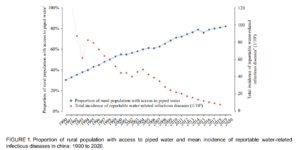 Abstract/Summary: In the 1950s, shortly after the founding of the People’s Republic of China (PRC), the central government created the Patriotic Health Campaign (PHC) in order to standardize and disseminate health focused educational materials intended to control and prevent infectious diseases (1). “Water improvement”, meaning measures aimed at providing safe drinking water for households in China, was an important part of the PHC. After 60 years of water improvement policies, programs, and investments, the rural water supply sanitation and hygiene in China has improved dramatically, and water-related diseases no longer negatively impact the rural population as they once did. In addition to improvements related to the quantity and quality of the rural water supply, water improvement programs also promoted improved hygiene, sanitation, and other health-related behaviors among rural households. Together, such initiatives have improved the quality of life and the health of hundreds of millions of rural residents, while also contributing to economic and social advancement across rural China (2). The purpose of this article is to describe how the PHC served as a foundation for the expansion and improvement of drinking water supply in rural China, and to summarize the key programs, projects, and initiatives that followed over the last 60 years.
Abstract/Summary: In the 1950s, shortly after the founding of the People’s Republic of China (PRC), the central government created the Patriotic Health Campaign (PHC) in order to standardize and disseminate health focused educational materials intended to control and prevent infectious diseases (1). “Water improvement”, meaning measures aimed at providing safe drinking water for households in China, was an important part of the PHC. After 60 years of water improvement policies, programs, and investments, the rural water supply sanitation and hygiene in China has improved dramatically, and water-related diseases no longer negatively impact the rural population as they once did. In addition to improvements related to the quantity and quality of the rural water supply, water improvement programs also promoted improved hygiene, sanitation, and other health-related behaviors among rural households. Together, such initiatives have improved the quality of life and the health of hundreds of millions of rural residents, while also contributing to economic and social advancement across rural China (2). The purpose of this article is to describe how the PHC served as a foundation for the expansion and improvement of drinking water supply in rural China, and to summarize the key programs, projects, and initiatives that followed over the last 60 years.
PDF on Publisher Website | PDF on OSF
Boiled or Bottled: Regional and Seasonal Exposures to Drinking Water Contamination and Household Air Pollution in Rural China
Authors: Cohen, A., Pillarisetti, A., Luo, Q., Zhang, Q., Li, H., Zhong, G., Zhu, G., Colford, J. M., Smith, K. R., Ray, I., & Tao, Y.
Publication Year: 2020 | Journal / Publisher: Environmental Health Perspectives
Abstract/Summary: We assessed the regional and seasonal prevalence of HWT practices (including bottled water use) in low-income rural areas in two Chinese provinces, evaluated the microbiological safety of drinking water and associated health outcomes, and estimated the air pollution burden associated with the use of solid fuels for boiling. Methods: We conducted cross-sectional surveys and collected drinking water samples from 1,033 rural households in Guangxi and Henan provinces. Temperature sensors affixed to pots and electric kettles were used to corroborate self-reported boiling frequencies and durations, which were used to model household air pollution (HAP) in terms of estimated particulate matter ≤2.5μm in aerodynamic diameter (PM2.5) concentrations. Results: Based on summer data collection in both provinces, after controlling for covariates, boiling with electric kettles was associated with the largest log reduction in thermotolerant coliforms (TTCs) (0.66log10 TTC most probable number/100mL), followed by boiling with pots (−0.58), and bottled water use (−0.39); all were statistically significant (p<0.001). Boiling with electric kettles was associated with a reduced risk of TTC contamination [risk ratio (RR)=0.25, p<0.001] and reported diarrhea (RR=0.80, p=0.672). TTCs were detected in 51% (n=136) of bottled water samples. For households boiling with biomass, modeled PM2.5 concentrations averaged 79 μg/m3 (standard deviation=21). Discussion: Our findings suggest that where boiling is already common and electricity access is widespread, the promotion of electricity-based boiling may represent a pragmatic stop-gap means of expanding safe water access until centralized, or decentralized, treated drinking water is available; displacing biomass use for water boiling could also reduce HAP concentrations and exposures. Our results also highlight the risks of increasing bottled water use in rural areas, and its potential to displace other sources of safe drinking water, which could in turn hamper efforts in China and other LMICs toward universal and affordable safe water access.
PDF on Publisher Website | PDF on OSF
Predictors of drinking water boiling & bottled water consumption in rural China: A hierarchical modeling approach
Authors: Cohen, A., Zhang, Q., Luo, Q., Tao, Y., Colford, J. M., & Ray, I.
Publication Year: 2017 | Journal / Publisher: Environmental Science & Technology
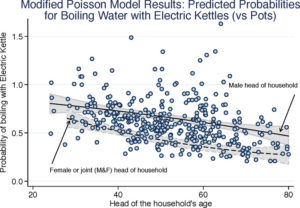 Abstract/Summary: Approximately two billion people drink unsafe water. Boiling is the most commonly used household water treatment (HWT) method globally and in China. HWT can make water safer, but sustained adoption is rare and bottled water consumption is growing. To successfully promote HWT, an understanding of associated socioeconomic factors is critical. We collected survey data and water samples from 450 rural households in Guangxi Province, China. Covariates were grouped into blocks to hierarchically construct modified Poisson models and estimate risk ratios (RR) associated with boiling methods, bottled water, and untreated water. Female-headed households were most likely to boil (RR = 1.36, p < 0.01), and among boilers those using electric kettles rather than pots had higher income proxies (e.g., per capita TV ownership RR = 1.42, p < 0.01). Higher-income households with younger, literate, and male heads were more likely to purchase (frequently contaminated) bottled water, or use electric kettles if they boiled. Our findings show that boiling is not an undifferentiated practice, but one with different methods of varying effectiveness, environmental impact, and adoption across socioeconomic strata. Our results can inform programs to promote safer and more efficient boiling using electric kettles, and suggest that if rural China’s economy continues to grow then bottled water use will increase.
Abstract/Summary: Approximately two billion people drink unsafe water. Boiling is the most commonly used household water treatment (HWT) method globally and in China. HWT can make water safer, but sustained adoption is rare and bottled water consumption is growing. To successfully promote HWT, an understanding of associated socioeconomic factors is critical. We collected survey data and water samples from 450 rural households in Guangxi Province, China. Covariates were grouped into blocks to hierarchically construct modified Poisson models and estimate risk ratios (RR) associated with boiling methods, bottled water, and untreated water. Female-headed households were most likely to boil (RR = 1.36, p < 0.01), and among boilers those using electric kettles rather than pots had higher income proxies (e.g., per capita TV ownership RR = 1.42, p < 0.01). Higher-income households with younger, literate, and male heads were more likely to purchase (frequently contaminated) bottled water, or use electric kettles if they boiled. Our findings show that boiling is not an undifferentiated practice, but one with different methods of varying effectiveness, environmental impact, and adoption across socioeconomic strata. Our results can inform programs to promote safer and more efficient boiling using electric kettles, and suggest that if rural China’s economy continues to grow then bottled water use will increase.
PDF on Publisher Website | PDF on OSF
Microbiological evaluation of household drinking water treatment in rural China shows benefits of electric kettles: A cross-sectional study
Authors: Cohen, A., Tao, Y., Luo, Q., Zhong, G., Romm, J., Colford, J. M., & Ray, I.
Publication Year: 2015 | Journal / Publisher: PLoS ONE
 Abstract: Background – In rural China ~607 million people drink boiled water, yet little is known about prevailing household water treatment (HWT) methods or their effectiveness. Boiling, the most common HWT method globally, is microbiologically effective, but household air pollution (HAP) from burning solid fuels causes cardiovascular and respiratory disease, and black carbon emissions exacerbate climate change. Boiled water is also easily re-contaminated. Our study was designed to identify the HWT methods used in rural China and to evaluate their effectiveness. Methods – We used a geographically stratified cross-sectional design in rural Guangxi Province to collect survey data from 450 households in the summer of 2013. Household drinking water samples were collected and assayed for Thermotolerant Coliforms (TTC), and physicochemical analyses were conducted for village drinking water sources. In the winter of 2013–2104, we surveyed 120 additional households and used remote sensors to corroborate selfreported boiling data. Findings – Our HWT prevalence estimates were: 27.1% boiling with electric kettles, 20.3% boiling with pots, 34.4% purchasing bottled water, and 18.2% drinking untreated water (for these analyses we treated bottled water as a HWT method). Households using electric kettles had the lowest concentrations of TTC (73% lower than households drinking untreated water). Multilevel mixed-effects regression analyses showed that electric kettles were associated with the largest Log10TTC reduction (-0.60, p<0.001), followed by bottled water (-0.45, p<0.001) and pots (-0.44, p<0.01). Compared to households drinking untreated water, electric kettle users also had the lowest risk of having TTC detected in their drinking water (risk ratio, RR = 0.49, 0.34–0.70, p<0.001), followed by bottled water users (RR = 0.70, 0.53–0.93, p<0.05) and households boiling with pots (RR = 0.74, 0.54–1.02, p = 0.06). Conclusion: As far as we are aware, this is the first HWT-focused study in China, and the first to quantify the comparative advantage of boiling with electric kettles over pots. Our results suggest that electric kettles could be used to rapidly expand safe drinking water access and reduce HAP exposure in rural China.
Abstract: Background – In rural China ~607 million people drink boiled water, yet little is known about prevailing household water treatment (HWT) methods or their effectiveness. Boiling, the most common HWT method globally, is microbiologically effective, but household air pollution (HAP) from burning solid fuels causes cardiovascular and respiratory disease, and black carbon emissions exacerbate climate change. Boiled water is also easily re-contaminated. Our study was designed to identify the HWT methods used in rural China and to evaluate their effectiveness. Methods – We used a geographically stratified cross-sectional design in rural Guangxi Province to collect survey data from 450 households in the summer of 2013. Household drinking water samples were collected and assayed for Thermotolerant Coliforms (TTC), and physicochemical analyses were conducted for village drinking water sources. In the winter of 2013–2104, we surveyed 120 additional households and used remote sensors to corroborate selfreported boiling data. Findings – Our HWT prevalence estimates were: 27.1% boiling with electric kettles, 20.3% boiling with pots, 34.4% purchasing bottled water, and 18.2% drinking untreated water (for these analyses we treated bottled water as a HWT method). Households using electric kettles had the lowest concentrations of TTC (73% lower than households drinking untreated water). Multilevel mixed-effects regression analyses showed that electric kettles were associated with the largest Log10TTC reduction (-0.60, p<0.001), followed by bottled water (-0.45, p<0.001) and pots (-0.44, p<0.01). Compared to households drinking untreated water, electric kettle users also had the lowest risk of having TTC detected in their drinking water (risk ratio, RR = 0.49, 0.34–0.70, p<0.001), followed by bottled water users (RR = 0.70, 0.53–0.93, p<0.05) and households boiling with pots (RR = 0.74, 0.54–1.02, p = 0.06). Conclusion: As far as we are aware, this is the first HWT-focused study in China, and the first to quantify the comparative advantage of boiling with electric kettles over pots. Our results suggest that electric kettles could be used to rapidly expand safe drinking water access and reduce HAP exposure in rural China.
PDF on Publisher Website | PDF on OSF
The Multidimensional Poverty Assessment Tool: Brochure (& Infographics)
Authors: IFAD [Cohen, A.]
Publication Year: 2014 | Journal / Publisher: United Nations International Fund for Agricultural Development
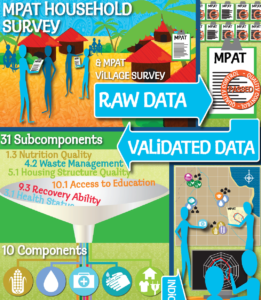 Abstract/Summary: The Multidimensional Poverty Assessment Tool (MPAT) provides data that can inform all levels of decision making by providing a clearer understanding of rural poverty at the household and village level. As a result, MPAT can significantly strengthen the planning, design, monitoring and evaluation of a project, and thereby contribute to rural poverty reduction.
Abstract/Summary: The Multidimensional Poverty Assessment Tool (MPAT) provides data that can inform all levels of decision making by providing a clearer understanding of rural poverty at the household and village level. As a result, MPAT can significantly strengthen the planning, design, monitoring and evaluation of a project, and thereby contribute to rural poverty reduction.
This brochure explains:
-
- What MPAT is
- How MPAT works
- When to use MPAT and why
- How to use MPAT
- What resources are available for implementing MPAT
The tool allows project managers, government officials, researchers and others to identify and monitor sectors that require support in order to reduce rural poverty and improve livelihoods. It also provides an objective means of justifying resource allocation or planning priorities. MPAT is based on a bottom-up, participatory approach that reflects communities’ voices, wants and perspectives.
PDF on Publisher Website | PDF on OSF
The Multidimensional Poverty Assessment Tool: User’s Guide
Authors: IFAD [Cohen, A. & Jayne, S.]
Publication Year: 2014 | Journal / Publisher: United Nations International Fund for Agricultural Development
 Abstract/Summary: The Multidimensional Poverty Assessment Tool (MPAT) provides a method for simplifying the complexity of rural poverty in order to support poverty alleviation efforts. MPAT uses thoroughly designed and tested purpose-built surveys to collect data on people’s perceptions about fundamental and interconnected aspects of their lives, livelihoods and environments. Standardized indicators, developed through a comprehensive participatory process, are then employed to combine, distil and present these data in an accessible way. MPAT was developed through a participatory, collaborative process based on expert feedback from dozens of international development experts from IFAD, other United Nations agencies, international and regional organizations, and universities from around the world. It was field-tested in countries in both Asia and Africa. In the pages that follow, we explain what MPAT is, how it works and how it is used, providing step-by-step instructions, training materials and other resources. The ultimate objective of this User’s Guide and the accompanying Excel Spreadsheet is to make MPAT a truly free and open-source tool, so that any institution or agency, big or small, may implement MPAT on its own.
Abstract/Summary: The Multidimensional Poverty Assessment Tool (MPAT) provides a method for simplifying the complexity of rural poverty in order to support poverty alleviation efforts. MPAT uses thoroughly designed and tested purpose-built surveys to collect data on people’s perceptions about fundamental and interconnected aspects of their lives, livelihoods and environments. Standardized indicators, developed through a comprehensive participatory process, are then employed to combine, distil and present these data in an accessible way. MPAT was developed through a participatory, collaborative process based on expert feedback from dozens of international development experts from IFAD, other United Nations agencies, international and regional organizations, and universities from around the world. It was field-tested in countries in both Asia and Africa. In the pages that follow, we explain what MPAT is, how it works and how it is used, providing step-by-step instructions, training materials and other resources. The ultimate objective of this User’s Guide and the accompanying Excel Spreadsheet is to make MPAT a truly free and open-source tool, so that any institution or agency, big or small, may implement MPAT on its own.
PDF on Publisher Website | PDF on OSF
The Multidimensional Poverty Assessment Tool: A new framework for measuring rural poverty.
Authors: Cohen, A.
Publication Year: 2010 | Journal / Publisher: Development in Practice
 The Multidimensional Poverty Assessment Tool (MPAT) measures fundamental dimensions of rural poverty in order to support poverty-alleviation efforts in the less developed world. This article’s primary purpose is to introduce MPAT and describe its theoretical rationale. It begins with an overview of the importance of creating enabling environments for rural poverty alleviation before describing MPAT’s purpose and structure. The article goes on to address some of the advantages and shortcomings of surveys and indicators as means of measuring poverty, and concludes with a few caveats on using MPAT, and a focus on its added value to practitioners and academics.
The Multidimensional Poverty Assessment Tool (MPAT) measures fundamental dimensions of rural poverty in order to support poverty-alleviation efforts in the less developed world. This article’s primary purpose is to introduce MPAT and describe its theoretical rationale. It begins with an overview of the importance of creating enabling environments for rural poverty alleviation before describing MPAT’s purpose and structure. The article goes on to address some of the advantages and shortcomings of surveys and indicators as means of measuring poverty, and concludes with a few caveats on using MPAT, and a focus on its added value to practitioners and academics.
PDF on Publisher Website | PDF on OSF
Water & poverty in rural China: Developing an instrument to assess the multiple dimensions of water & poverty
Authors: Cohen, A. & Sullivan, C.
Publication Year: 2010 | Journal / Publisher: Ecological Economics
 Abstract/Summary: This paper describes the theoretical foundations and development of a multidimensional, water-focused, thematic indicator of rural poverty: The Water, Economy, Investment and Learning Assessment Indicator (WEILAI). The WEILAI approach was specifically designed for application in rural China, to support poverty alleviation project planning, monitoring and evaluation, as well as targeting and prioritization. WEILAI builds primarily on the basic needs framework of poverty alleviation, and on the methodological structure of the Water Poverty Index, to provide a proxy measure of an area’s poverty by assessing eight key poverty sectors, with a strong focus on the components of water-poverty. The WEILAI approach was piloted and implemented in 534 households in China’s mountainous southwest. This paper describes the indicator construction, weighting schemes, methodology, field sites, and statistical validation of the results. In addition, we discuss the results, feedback from in-country project staff, and the likely utility of the tool for project planning, monitoring and evaluation support. The paper concludes with a discussion of WEILAI’s overall utility and ongoing development.
Abstract/Summary: This paper describes the theoretical foundations and development of a multidimensional, water-focused, thematic indicator of rural poverty: The Water, Economy, Investment and Learning Assessment Indicator (WEILAI). The WEILAI approach was specifically designed for application in rural China, to support poverty alleviation project planning, monitoring and evaluation, as well as targeting and prioritization. WEILAI builds primarily on the basic needs framework of poverty alleviation, and on the methodological structure of the Water Poverty Index, to provide a proxy measure of an area’s poverty by assessing eight key poverty sectors, with a strong focus on the components of water-poverty. The WEILAI approach was piloted and implemented in 534 households in China’s mountainous southwest. This paper describes the indicator construction, weighting schemes, methodology, field sites, and statistical validation of the results. In addition, we discuss the results, feedback from in-country project staff, and the likely utility of the tool for project planning, monitoring and evaluation support. The paper concludes with a discussion of WEILAI’s overall utility and ongoing development.
PDF on Publisher Website | PDF on OSF
InnoWat Topic Sheet: [Pro-poor] Payments for watershed services
Authors: Cohen, A.
Publication Year: 2009 | Journal / Publisher: Rome: United Nations International Fund for Agricultural Development
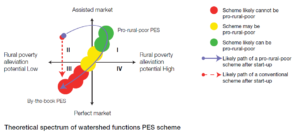 Payments for environmental services (PES) are a means of creating a market in environmental/ecosystem services. They link those who value a given service with those who can provide it. Most early PES initiatives were in Latin America, which remains the region with the most PES schemes, followed by Asia, and lastly Africa (figure 1). Payments for watershed functions seek to link upstream land use and management with downstream water use and management to realize benefits for upstream and downstream participants in the scheme and others in the area – not to mention for the environment. The ideal is a voluntary agreement between at least one buyer and one seller of ecosystem services (or land-use changes presumed to provide an ecosystem service). PES schemes have become increasingly popular with donors over the last few years. Yet despite their widespread application, by their nature they are not primarily intended as a tool for poverty reduction. They may be tailored to this purpose, however. From IFAD’s perspective, the problem is that poor rural people lack the prerequisites for participation in PES. Often, they do not have secure land tenure, rewards are easily usurped by the elite, and they lack the assets (human capital, natural resources) to provide the level of service needed to yield the desired impacts. Part of the solution to this stubborn dilemma may be to eschew PES schemes that simply seek market creation. Rather than clinging to economic principles, develop a variant of PES that builds on the reality faced in rural areas. This means allowing for market support, subsidies and a means of directing PES benefits to poor people – in short, developing pro-rural-poor PES.
Payments for environmental services (PES) are a means of creating a market in environmental/ecosystem services. They link those who value a given service with those who can provide it. Most early PES initiatives were in Latin America, which remains the region with the most PES schemes, followed by Asia, and lastly Africa (figure 1). Payments for watershed functions seek to link upstream land use and management with downstream water use and management to realize benefits for upstream and downstream participants in the scheme and others in the area – not to mention for the environment. The ideal is a voluntary agreement between at least one buyer and one seller of ecosystem services (or land-use changes presumed to provide an ecosystem service). PES schemes have become increasingly popular with donors over the last few years. Yet despite their widespread application, by their nature they are not primarily intended as a tool for poverty reduction. They may be tailored to this purpose, however. From IFAD’s perspective, the problem is that poor rural people lack the prerequisites for participation in PES. Often, they do not have secure land tenure, rewards are easily usurped by the elite, and they lack the assets (human capital, natural resources) to provide the level of service needed to yield the desired impacts. Part of the solution to this stubborn dilemma may be to eschew PES schemes that simply seek market creation. Rather than clinging to economic principles, develop a variant of PES that builds on the reality faced in rural areas. This means allowing for market support, subsidies and a means of directing PES benefits to poor people – in short, developing pro-rural-poor PES.
PDF on Publisher Website | PDF on OSF
InnoWat: IFAD & rural water investments
Authors: Cohen, A. & Nepveu de Villemarceau, A.
Publication Year: 2009 | Journal / Publisher: Rome: United Nations International Fund for Agricultural Development
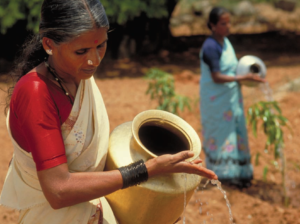 IFAD is currently engaged in over 230 loan operations in 85 countries. About two thirds of that portfolio is related to community-based natural resource management. Poor rural people and their institutions are at the core of this approach. Water is critical to these men and women pastoralists, fishers, farmers, young and old, part- or full-time, urban or rural, indigenous, tribal or otherwise often marginalized people. Itis the key entry point for improving their livelihoods. Water-related interventions are often linked to the building up or restoring of the asset base – and involve many facets and uses. This holistic view is part of the characterization of IFAD’s approach to water interventions in this fact sheet: rather than considering water solely as an input factor in the production chain, we have preferred to follow water throughout rural people’s livelihoods. This approach, combined with a qualitative analysis of the ongoing 2007/08 loan portfolio, yielded a few surprising insights (table 1).Almost half of all projects (45-50 per cent) involve aspects of water resource management at catchment or watershed levels, and hence beyond the immediate household or community level of use.
IFAD is currently engaged in over 230 loan operations in 85 countries. About two thirds of that portfolio is related to community-based natural resource management. Poor rural people and their institutions are at the core of this approach. Water is critical to these men and women pastoralists, fishers, farmers, young and old, part- or full-time, urban or rural, indigenous, tribal or otherwise often marginalized people. Itis the key entry point for improving their livelihoods. Water-related interventions are often linked to the building up or restoring of the asset base – and involve many facets and uses. This holistic view is part of the characterization of IFAD’s approach to water interventions in this fact sheet: rather than considering water solely as an input factor in the production chain, we have preferred to follow water throughout rural people’s livelihoods. This approach, combined with a qualitative analysis of the ongoing 2007/08 loan portfolio, yielded a few surprising insights (table 1).Almost half of all projects (45-50 per cent) involve aspects of water resource management at catchment or watershed levels, and hence beyond the immediate household or community level of use.
PDF on Publisher Website | PDF on OSF
InnoWat: Water, innovations, learning & rural livelihoods
Authors: Cleveringa, R., Kay, M,. & Cohen, A. (Eds.)
Publication Year: 2009 | Journal / Publisher: United Nations International Fund for Agricultural Development
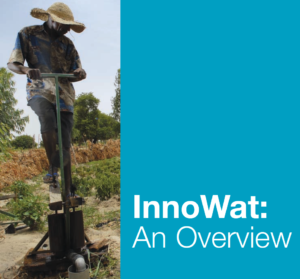 Abstract/Summary: The International Fund for Agricultural Development (IFAD) is a specialized agency of the United Nations dedicated to eradicating poverty in the rural areas of developing countries. Seventy-five per cent of the world’s poorest people, 800 million women, men and children, live in rural areas. Most depend on agriculture to survive. The IFAD team working on agricultural water management and rural infrastructure is developing its operational approach to water and rural poverty (WRP), under the aegis of the project for Learning and Knowledge on Innovations in Water and RuralPoverty (InnoWat). In light of the changing rural context within which poor rural people find themselves, the overall goal of InnoWat is essentially twofold:• strengthen IFAD capacity as a knowledge management broker for development partners interested in WRP, in accordance with IFAD’s mandate; and• provide IFAD country programme managers (CPMs) and their design teams with practical tools for project development, implementation and pro-poor, water related interventions. The team has created the present kit – InnoWat: Water, innovations, learning and rurallivelihoods1 – with the expectation that it will be useful to IFAD CPMs and will enhance IFAD’s comparative advantage with respect to rural poverty reduction and water issues.
Abstract/Summary: The International Fund for Agricultural Development (IFAD) is a specialized agency of the United Nations dedicated to eradicating poverty in the rural areas of developing countries. Seventy-five per cent of the world’s poorest people, 800 million women, men and children, live in rural areas. Most depend on agriculture to survive. The IFAD team working on agricultural water management and rural infrastructure is developing its operational approach to water and rural poverty (WRP), under the aegis of the project for Learning and Knowledge on Innovations in Water and RuralPoverty (InnoWat). In light of the changing rural context within which poor rural people find themselves, the overall goal of InnoWat is essentially twofold:• strengthen IFAD capacity as a knowledge management broker for development partners interested in WRP, in accordance with IFAD’s mandate; and• provide IFAD country programme managers (CPMs) and their design teams with practical tools for project development, implementation and pro-poor, water related interventions. The team has created the present kit – InnoWat: Water, innovations, learning and rurallivelihoods1 – with the expectation that it will be useful to IFAD CPMs and will enhance IFAD’s comparative advantage with respect to rural poverty reduction and water issues.
PDF on Publisher Website | PDF on OSF
Synthesis of strategic approaches: Enhancing pro-poor investments in water & rural livelihoods.
Authors: Cleveringa, R., Kay, M., & Cohen, A.
Publication Year: 2009 | Journal / Publisher: Rome: United Nations International Fund for Agricultural Development
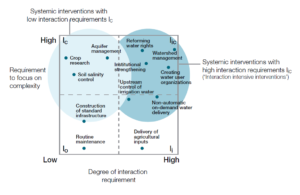 The reduction of hunger and poverty depends on improved access to water for poor rural people. Progress in community water supplies and agricultural water management (AWM), particularly irrigation, is one of the success stories of the twentieth century. However, it is disappointing to learn that AWM, by far the largest consumer of water in developing countries, has had little impact on world hunger and poverty. The experience of agency- and government-led interventions has not been good. They often impose ‘blueprint’ methods that ignore important local issues. A critical gap exists between planning and successful implementation. Approaches focus on what needs to be done, rather than on how to do it, and they ignore the complex interactions among individuals, the state and service providers –as well as their limited capacity to translate plans into practice. If poor rural people are not to be the losers again in the struggle for declining water resources, a new, pro-poor water management strategy is needed. It must focus more on how to do it, while still addressing what to do, where and with whom.
The reduction of hunger and poverty depends on improved access to water for poor rural people. Progress in community water supplies and agricultural water management (AWM), particularly irrigation, is one of the success stories of the twentieth century. However, it is disappointing to learn that AWM, by far the largest consumer of water in developing countries, has had little impact on world hunger and poverty. The experience of agency- and government-led interventions has not been good. They often impose ‘blueprint’ methods that ignore important local issues. A critical gap exists between planning and successful implementation. Approaches focus on what needs to be done, rather than on how to do it, and they ignore the complex interactions among individuals, the state and service providers –as well as their limited capacity to translate plans into practice. If poor rural people are not to be the losers again in the struggle for declining water resources, a new, pro-poor water management strategy is needed. It must focus more on how to do it, while still addressing what to do, where and with whom.
PDF on Publisher Website | PDF on OSF
The Multidimensional Poverty Assessment Tool: Design, development & application of a new framework for measuring rural poverty
Authors: Cohen, A.
Publication Year: 2009 | Journal / Publisher: United Nations International Fund for Agricultural Development
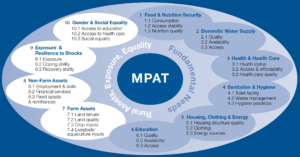 Abstract/Summary: The purpose of this book is to describe the theoretical foundations upon which the Multidimensional Poverty Assessment Tool (MPAT) was built, to tell the story of how it was created, developed, tested and piloted in rural China and India, and to explain how MPAT can be used to benefit rural communities around the world. Lasting poverty alleviation is achieved by fostering a comprehensive enabling environment within which people have a sufficiently high level of well-being and are able to pursue their livelihood goals based on their aspirations and initiative. To ensure that such environments are in place requires, at a minimum, an understanding of the key constraints rural people face – the fundamental dimensions central to their lives and livelihoods. MPAT does not try to define rural poverty per se; rather it takes a step back from assessment modalities that are overly focused on economic- and consumption-oriented indicators and strives to provide an overview of fundamental and relatively universal dimensions germane to rural livelihoods, rural life, and thus to rural poverty. By summarizing rural communities’ perceptions about key dimensions of rural poverty and focusing them through a quantitative lens, MPAT transparently illuminates problem areas so that all stakeholders can see where deficiencies lie and can begin to discuss which interventions may be most appropriate to address them, based on the local context.
Abstract/Summary: The purpose of this book is to describe the theoretical foundations upon which the Multidimensional Poverty Assessment Tool (MPAT) was built, to tell the story of how it was created, developed, tested and piloted in rural China and India, and to explain how MPAT can be used to benefit rural communities around the world. Lasting poverty alleviation is achieved by fostering a comprehensive enabling environment within which people have a sufficiently high level of well-being and are able to pursue their livelihood goals based on their aspirations and initiative. To ensure that such environments are in place requires, at a minimum, an understanding of the key constraints rural people face – the fundamental dimensions central to their lives and livelihoods. MPAT does not try to define rural poverty per se; rather it takes a step back from assessment modalities that are overly focused on economic- and consumption-oriented indicators and strives to provide an overview of fundamental and relatively universal dimensions germane to rural livelihoods, rural life, and thus to rural poverty. By summarizing rural communities’ perceptions about key dimensions of rural poverty and focusing them through a quantitative lens, MPAT transparently illuminates problem areas so that all stakeholders can see where deficiencies lie and can begin to discuss which interventions may be most appropriate to address them, based on the local context.
PDF on Publisher Website | PDF on OSF
The Rural Water Livelihoods Index. Working Paper
Authors: Sullivan, C., Cohen, A., Faurès, J. M., & Santini, G.
Publication Year: 2008 | Journal / Publisher: Food & Agriculture Organization of the United Nations
 Abstract/Summary: The Rural Water Livelihood Index (RWLI) is calculated on the basis of components and indicator values representing each of these four dimensions. The resulting composite index reflects the values for these four dimensions, and on this basis, judgements can be made on how water management might be improved. Each of the four dimensions (components) of the RWLI are represented by two subcomponents, which are combined using a weighted average. In this report, this framework is applied at the national scale, but the approach can be used at any scale as long as appropriate data is available. The purpose of the RWLI is to provide policy makers and planners at the national level an overview of where their country stands relative to others (much like the Human Development Index), and relative to themselves over time, to examine and monitor progress being made as a result of actions taken. This in turn will hopefully allow for better targeted water related interventions to improve rural livelihoods. Through the measurement of these key components, it will be possible to assess which of the four dimensions are most likely to benefit from interventions. Appropriate interventions are context-specific and will have to be identified on a country-by-country basis since contexts differ so widely (i.e., responses to address the reported states will be country and site-specific). However, a general Response Matrix is being developed to provide planners and policy makers a conceptual framework to guide this process and at a macro-level the index values help national-level planners identify which sectors might be most in need of assistance.
Abstract/Summary: The Rural Water Livelihood Index (RWLI) is calculated on the basis of components and indicator values representing each of these four dimensions. The resulting composite index reflects the values for these four dimensions, and on this basis, judgements can be made on how water management might be improved. Each of the four dimensions (components) of the RWLI are represented by two subcomponents, which are combined using a weighted average. In this report, this framework is applied at the national scale, but the approach can be used at any scale as long as appropriate data is available. The purpose of the RWLI is to provide policy makers and planners at the national level an overview of where their country stands relative to others (much like the Human Development Index), and relative to themselves over time, to examine and monitor progress being made as a result of actions taken. This in turn will hopefully allow for better targeted water related interventions to improve rural livelihoods. Through the measurement of these key components, it will be possible to assess which of the four dimensions are most likely to benefit from interventions. Appropriate interventions are context-specific and will have to be identified on a country-by-country basis since contexts differ so widely (i.e., responses to address the reported states will be country and site-specific). However, a general Response Matrix is being developed to provide planners and policy makers a conceptual framework to guide this process and at a macro-level the index values help national-level planners identify which sectors might be most in need of assistance.
PDF on Publisher Website | PDF on OSF

